Amazon keyword research is a critical part of your Amazon FBA product’s success in 2024. However, even the idea of performing Amazon keyword research can seem somewhat overwhelming.
Where do you start? What Amazon keywords are best? Which ones should you use?
But no worries! We’ve got you covered. This article will teach you everything you need to know about Amazon keyword research to help ensure your success in 2024 and beyond.
Oh, and if you’re just here looking for an awesome Amazon keyword research tool, we’ve got you covered there, too. Check out Jungle Scout’s Keyword Scout.
Amazon’s A9 Search Algorithm
Amazon is a search engine, pure and simple.
But unlike Google, whose search engine can be used for information, news, images, videos, and even shopping, Amazon’s search engine has one goal: sell products.
And that’s what A9 (the name for Amazon’s search engine) does. It organizes the millions of products being sold on Amazon with that one goal in mind.
So how does a product win an Amazon A9 search? Relevance.
The last thing Amazon wants, when a customer performs a search, is to offer them a product unrelated to the one they were looking for.
Instead, the A9 search engine wants to make sure that the product the customer wants appears within the first two or three search results.
The less scrolling a customer does, the more likely they are to purchase.
Amazon keyword research and product relevance
So what is product relevance? Why is it important for Amazon keyword research?
First, it’s important to know a few things about what creates product relevance.
While most Amazon keyword research experts (those who don’t work at Amazon, that is) think they have a good idea of what works as a ranking signal for Amazon, they’re mostly just educated guesses.
After all, Amazon’s not about to give away its search engine’s secrets. If they did, everyone would make sure their products ranked #1. Total chaos!
Regardless, here are the elements that we believe are factors for Amazon keyword research and product relevance:
1. Conversion rate and sales velocity
What products do people want to buy? The ones other people buy, of course!
And to determine what people want, Amazon uses two metrics: conversion rate, and sales velocity.
What is a conversion rate?
Conversion rate is a business metric that measures the likelihood that someone will buy a certain product.
The conversion rate equals the number of sales a product makes divided by the total number of impressions (a fancy word for views) the page receives.
Across most industries, the average conversion rate is around 2.35%. Top sites, however, convert at 5.31% or higher. But Amazon’s average conversion rate? It hovers around a comparatively massive 13%!
What is sales velocity?
Sales velocity, on the other hand, is a bit more complicated.
Essentially, though, it roughly equals the number of opportunities (in this case, page impressions) multiplied by the average sale, multiplied by the conversion rate, all divided by the sales length cycle.
Did your brain just freeze? Mine, too. Here’s an example, to help clarify how sales velocity is calculated:
- In one month, your product page has 3,000 opportunities to make a sale.
- The average sale is $20.
- Your conversion rate is 10%.
- And the sales length cycle is 30 days.
- ((3000 x 20) 0.10 / 30 = 200
That means your sales velocity is $200, and you’re bringing in that much (approximately) every day.
2. Product title
But what if you’ve had little to no sales?
That’s where Amazon’s next big helper comes in. The product title.
Every product on Amazon gets a title, obviously. But titles do more than just help customers know what you are selling. It tells Amazon’s A9 search engine what your product is too.
As of this writing, Amazon allows sellers up to 200 characters in the title.
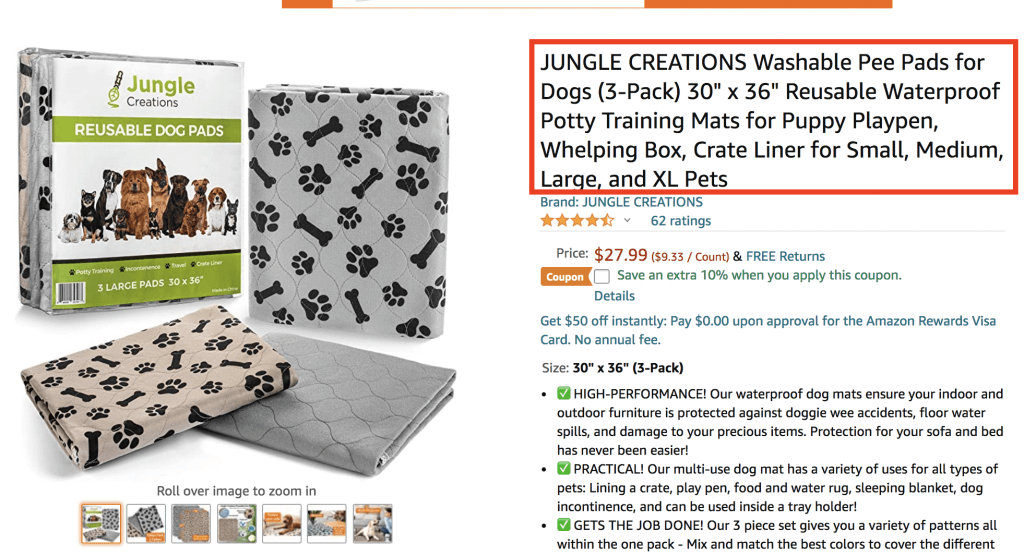
Until you start getting sales, the title (and a few of the details in the product listing itself) is the only categorizer Amazon possesses.
That is why it is absolutely crucial you perform proper Amazon keyword research before listing your product and creating its title.
3. Bullet points
While your bullet points may not carry as much weight as the title, they’re still important when it comes to search engine optimization on Amazon. You can use the available space in your five bullet points to include additional highly relevant keywords you couldn’t fit into the title, which only has a limit of 200 characters.
Your bullet points can also help your customer understand your product better. Use this space to explain the features and benefits of your product while keeping it short and to the point. Don’t stuff your bullet points with keywords and fill them with unnecessary fluff.
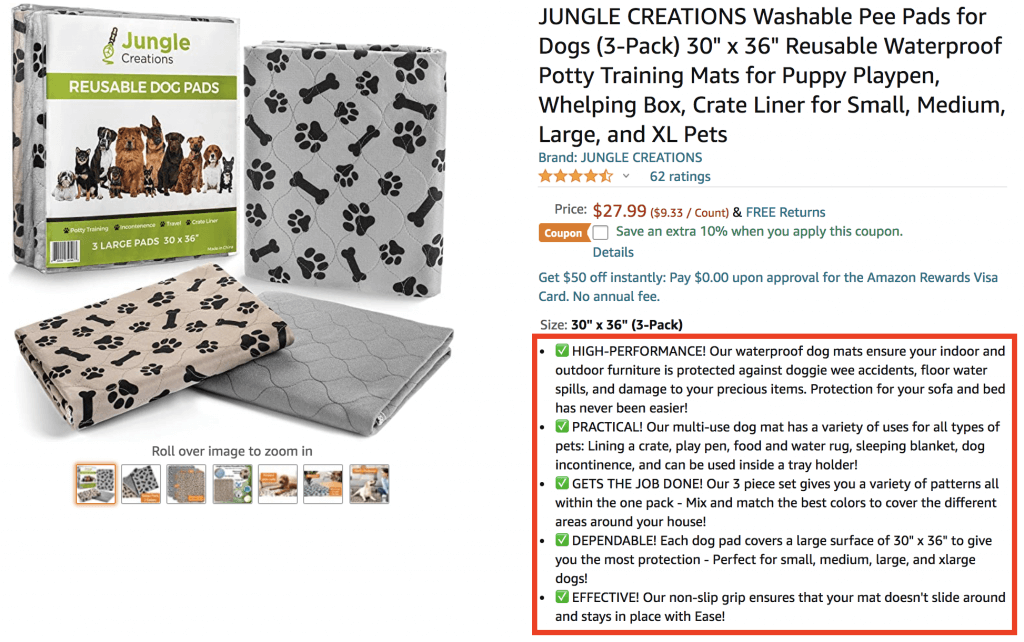
4. Description
Scrolling down the page, you’ll find the product’s description.
Again, the description is not as important as the title when it comes to Amazon product research, but it does help your customer make a final buying decision.
In a way, your product description is your closer.
If your customer has scrolled down to the description, they’re probably still on the fence about whether or not to buy the product. That’s why the description needs to be strong enough to close the deal.
If there are any additional, lower-volume keywords you were not able to fit in your title and bullet points, the description is a good space to add those.
5. Other possible ranking signals
Again, the A9 algorithm is a complicated bird.
Though the aforementioned factors are probably the most important elements Amazon uses for ranking, it’s unlikely they’re the only ones.
Amazon presumably considers reviews, back-end keywords, promotions, images, and more when ranking products.
Furthermore, Amazon is prone to changing the way they do things at the drop of a hat. So, what might help you rank today may not work for you tomorrow.
Amazon keyword research: how it’s done
Amazon keyword research is an art and a science. Okay, it’s more of a science. But it sounds less intimidating when I call it an art.
Also, it’s probably the single most important part of listing a product on Amazon. Having your products seen is a must! And the only way to do that is to make sure Amazon likes your product, right?
Ultimately, as I demonstrated above, relevance is key to success with Amazon’s search engine. And once you know the basics of Amazon keyword research, making your product relevant is a cinch.
Amazon keyword research: long tail vs. short tail
No two keyword phrases are created equal. In fact, SEO experts often use the terms “long tail” and “short tail” to describe the extremes of keyword research.
But what do these Amazon keyword research terms actually mean?
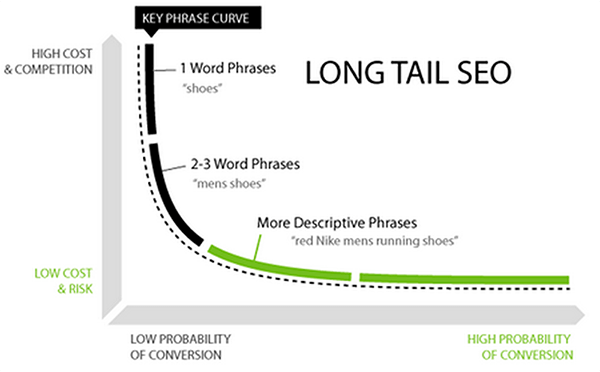
Looking at the graph above, you can see that the image has a curve weighted against cost and risk versus conversion.
At the high end of the curve, in black, are the short tail keyword phrases. Short tails are one, two, or three words long. And while the search volume is a lot higher for these types of terms, the costs are higher as well, thanks to increased competition.
On the other side of the curve, in green, are long-tail keyword phrases. Long-tail keyword phrases are much longer (four words or more), but have a higher probability of conversion and a lower cost.
The trade-off, of course, is that long-tail keywords have a smaller search volume than short-tail phrases. Therefore, you need a lot of long-tail keywords to make up that difference in search volume.
Here are some examples, demonstrating the difference between long-tail and short-tail.
Short tail:
Let’s say you want to sell shoes, like the above chart suggests, using that exact term.
The short tail term ‘shoes’ has a search volume as high as 1,000,000 per month. However, the keyword costs $5.00 per click due to the heavy competition surrounding the keyword.
Also, because your product doesn’t match what most shoppers are looking for, your conversion rate is sometimes as low as 1%. That means you’re spending as much as $500 in advertising PER sale!
With a gross profit of only $10, there’s probably no way to make that money back.
Long tail:
Alternatively, you decide to try to rank for the long tail Amazon keyword phrase ‘red Nike men’s running shoes’.
The phrase only gets 500 searches per month, but it’s also only $0.25 per click. Not to mention, the conversion rate averages a whopping 19%!
Now you’re only spending $1.32 in advertising per sale, making for a much healthier bottom line.
TL;DR: long tail = good, short tail = bad
So, while there are always plenty of short tail opportunities, the cost to convert is much too high. Long-tail keywords, in contrast, tend to be the safer, less expensive bet.
However, if you’re converting well with long-tail phrases, but your sales are still low, you need to add more long-tail phrases.
Remember, we need to add more long-tail keywords to our listings, to make up for their lower search volumes.
Amazon keyword research tactics
Now that you understand what sort of keywords you should be looking for, it’s time to actually find those keywords. Here’s how:
1. Run Amazon PPC automatic campaigns
When creating campaigns for Amazon pay-per-click advertising (PPC), you have two choices:
- Amazon PPC Manual Campaigns: These are the Amazon PPC campaigns where you choose the keywords. This can be tough to do, though, if you aren’t sure of what keywords to rank for. Finding and plugging in good keywords isn’t easy, right?
- Amazon PPC Automatic Campaigns. This type of campaign lets Amazon pick the keywords to promote your product. It tries different keywords for your product, looking for the ones that convert the best, then adjusts as needed.
So, start off by running an Amazon PPC automatic campaign. This might be counter-intuitive, but the best way to find keywords for Amazon is to let Amazon do the work for you.
After about a week, run a report for your keyword search terms (under Reports > Advertising) and sort the spreadsheet by best-converting keywords (conversion rate is your best guide to performing killer Amazon keyword research, and is Amazon’s way of telling you which keywords you should aim for).
Instead of running a search term report, you can also view the keywords Amazon is targeting within your campaign. In your advertising dashboard, go to the automatic campaign, click on the ad group, then click on “Search terms.”
Once you know which keywords are working (thanks to Amazon), you can take those keywords and run a manual campaign.
But don’t set them and forget them! It’s important to keep optimizing your listing’s keywords.
2. Reverse engineer your competitors’ keywords
Did you know that there are tools out there that let you see your competitor’s keywords? Jungle Scout has a feature called Keyword Scout, and it does just that.
All you have to do is plug in your competitor’s ASIN (Amazon Standard Identification Number for your product) into Keyword Scout, and it spits out all the keywords currently ranking for your competitor’s product.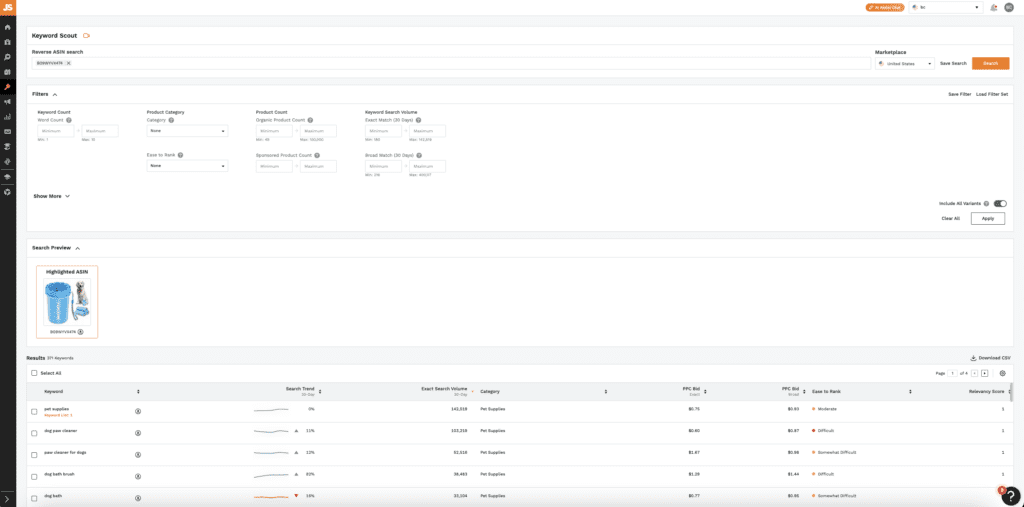
In the above example, I plugged in an ASIN for a dog paw cleaner. After setting my filters, Keyword Scout returned 371 keywords this product is ranking for.
We can see that this product ranks for terms such as “dog paw cleaner”, “paw cleaner for dogs”, and many more related keyword phrases. If I were to sell a similar product, I might try to rank for comparable keywords.
3. Use an Amazon keyword research tool to generate similar terms
In addition to reverse-ASIN lookups, we can come up with great keywords just by entering phrases into an Amazon keyword research tool.
Again, I’ll use Jungle Scout’s Keyword Scout to figure out new keywords for my product.
Using the same product type as above, I’m going to enter “dog paw cleaner” into Keyword Scout. Here are the keywords Keyword Scout tells me I should use. If you look to the right, you can see the estimated costs to rank on the first page for those keywords.
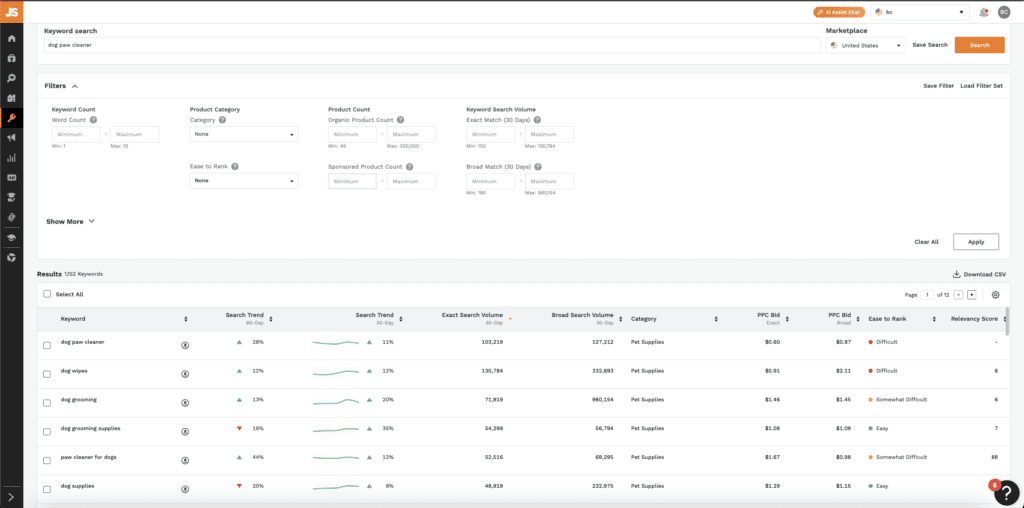
Not only does Keyword Scout show you the estimated PPC bid costs but the tool also shows you the “Ease to Rank.”
Search for “long tail keywords” within Keyword Scout because the longer tail keywords are typically more specific than a broad keyword search.
That’s how long-tail keywords work.
While the search volume is usually lower for longer-tailed keywords, they’re typically more relevant to the customer’s search.
Amazon keyword research: get to it!
Amazon keyword research is definitely not a “one-and-done” operation. To succeed on Amazon, you need to constantly tweak, edit, and adjust your keywords.
Fortunately, once you learn the tricks outlined in this article, keyword research should take up no more than a few hours of your time each week, leaving you with time to work on other projects.
So let’s get to it, and start optimizing our listings!
If you have any tricks you use for your research you’d like to share, feel free to drop them in the comments below!

 10 Comments
10 Comments
10 comments on “Amazon Keyword Research: Your Guide to Success in 2024”